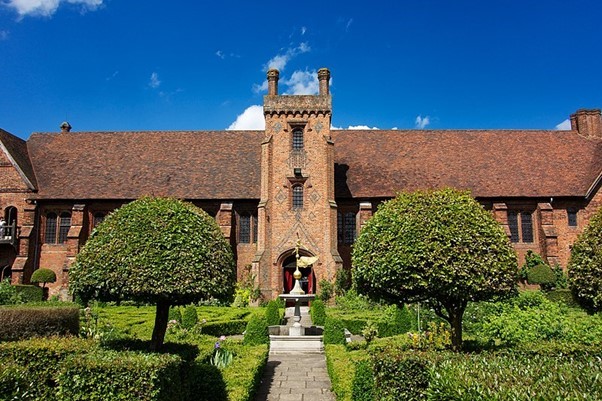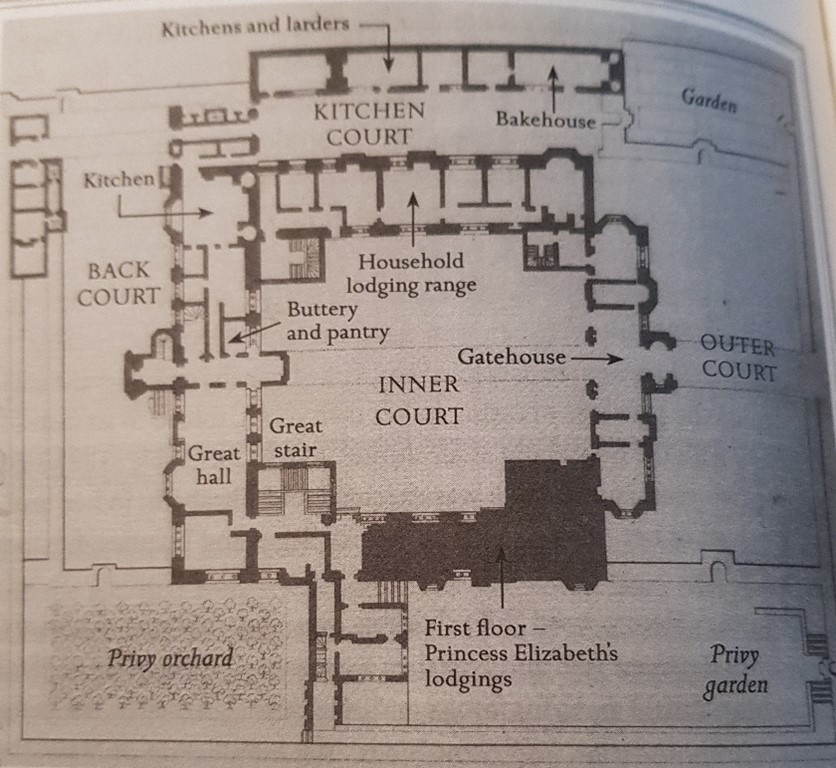Hatfield House
Royal Nursery
Chapter 1: Tudor Hatfield
Elizabeth I had a long association with Hatfield, which was one of her nursery houses. It was also the place to which she retreated during difficult times in the reigns of Edward VI and Mary I.
The manor of Hatfield was owned by the bishopric of Ely during the medieval period and their manor house, located some 20 miles north of London on the Great North Road, was a convenient location for the bishops to stay on their travels between Cambridgeshire and London. In the early 1480s, John Morton, then Bishop of Ely, built a new, large, two-storey, red-brick house, comprising four ranges around a central courtyard, sited to the east of the Bishops’ medieval manor house and next to St Etheldreda’s church. He was also responsible for the construction of a new tower on the thirteenth century church, both of which are still standing today.

Hatfield was popular with royal visitors during Nicholas West’s tenure as Bishop (1515 – 1533). Henry VIII’s sister, Mary, the French Queen, was staying at Hatfield when she gave birth to her daughter, Frances Brandon (mother of Lady Jane Grey) on 16 July 1517, who was baptised two days later at St Etheldreda’s church. Henry VIII visited Hatfield a number of times, staying for several weeks in 1522, where he was joined by Katharine of Aragon, whilst he was avoiding the plague in and around London, and again in 1528 whilst trying to avoid a severe epidemic of the sweating sickness.
It is thought that the state apartments which Elizabeth would have used during her residence at Hatfield were on the first floor of the south range, approached by a great stair and overlooking the garden. Simon Thurley suggests that Mary’s rooms are likely to have been on the ground floor of the south range, beneath Elizabeth’s, or in the guest lodgings in the north range.

Elizabeth was first taken to Hatfield as a 3-month-old baby in December 1533 under the care of her mother’s aunt, Anne, Lady Shelton, and Anne Boleyn visited the little princess there in spring 1534. Elizabeth's half-sister, Mary, freshly demoted from princess to illegitimate daughter of the king, was sent, as an attendant in the young Elizabeth’s household, to reside there for a time too, in what was effectively house arrest, for her refusal to accept the annulment of her parents’ marriage. Unable to walk in the gardens, nor attend church, Mary’s time at Hatfield was constrained and miserable. She was confined to her room during Henry’s visits, apart from one notable occasion when she watched from the rooftop as the king left Hatfield, to be rewarded by Henry and his entourage raising their caps to acknowledge her presence.
In 1538, Henry VIII acquired Hatfield House and continued to use it primarily as a nursery for Elizabeth and, sometimes for the young Prince Edward, who also had rooms there. On her father’s death, and to fulfill Henry's bequests, Hatfield was granted to Elizabeth and she spent a considerable amount of time there during the reigns of her siblings, Edward VI and Mary I. It was here, in 1549, that she was interrogated by Sir Roger Twyrhitt for two weeks over her relationship with Sir Thomas Seymour and the events that resulted in his execution. Elizabeth was also at Hatfield when her brother, Edward VI, died, and remained there, a suitable distance from the dramatic events of the accession crisis of 1553, which saw Lady Jane Grey briefly on the throne before Mary successfully claimed it. Hatfield was Elizabeth’s principal residence during much of her sister, Mary I’s, reign and she spent most of her time there once she was released from house arrest at Woodstock in 1555. Interestingly, given relations between the sisters and her previous experiences at Hatfield, Mary stayed as a guest of Elizabeth’s in April 1557, during which time she was lavishly entertained.
Elizabeth was at Hatfield when Mary died, on 17 November 1558, and she learned of her accession to the throne. The old oak tree in the park that, according to legend, Elizabeth was sitting under at the time, was replaced by a new sapling, planted by Queen Elizabeth II in 1985. Several days after her accession, Elizabeth held her first, informal, Council of State meeting, in the Great Hall, now known as the Banqueting Hall, where she called together her trusted advisors, including William Cecil and Robert Dudley. She left Hatfield on 23 November 1558, heading for her capital, London, and accompanied by an enormous retinue of lords, ladies and gentlemen. During her reign, Elizabeth returned to Hatfield occasionally, on her summer progresses. Her longest stays, lasting a week or so, were made in 1568 and 1571.
